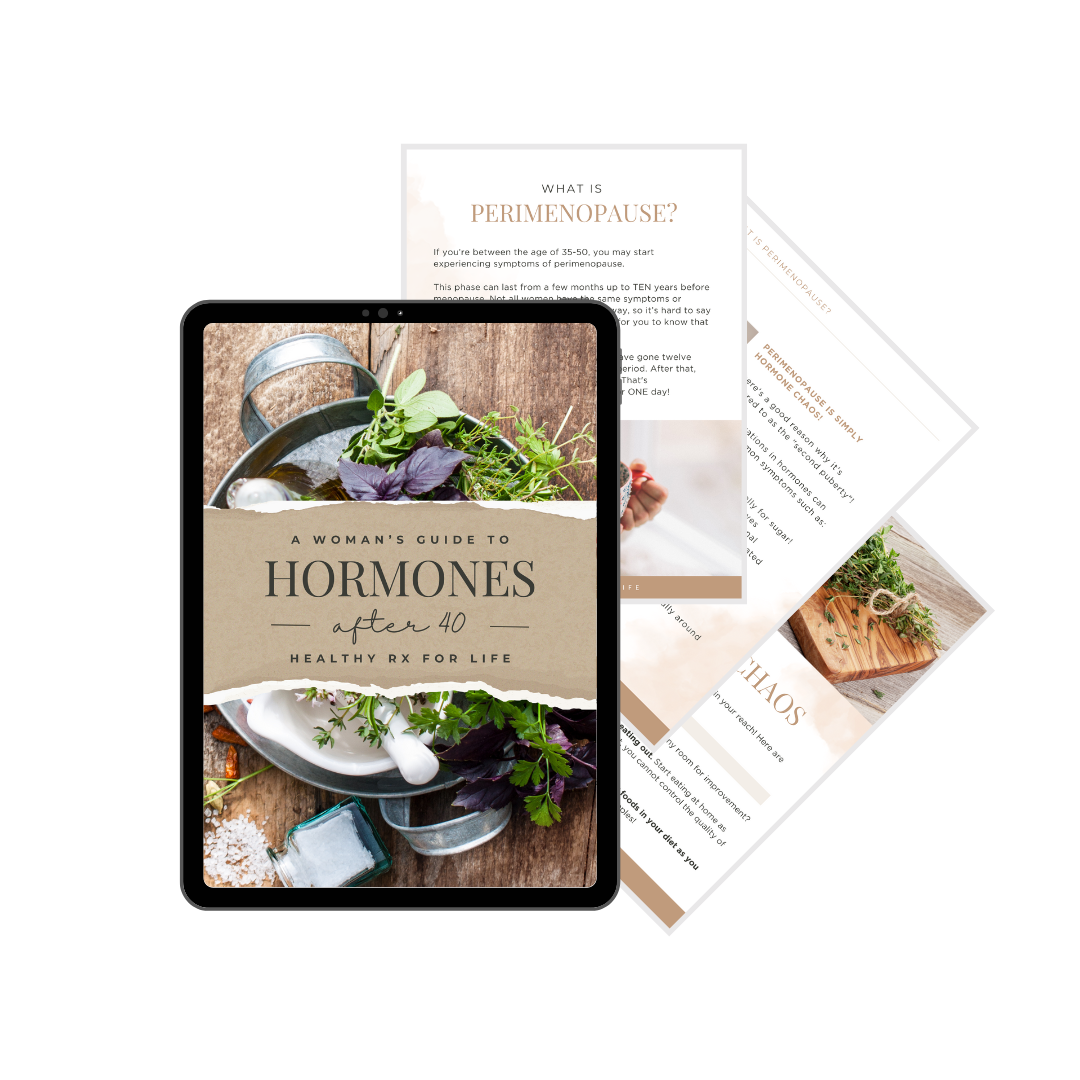What many women don’t know is that “hormone balance” isn’t a static state—it changes throughout your life!
Hormones fluctuate based on your age, lifestyle, and life stage, especially during the transition to menopause. One of the most critical, yet often confusing, stages of this journey is perimenopause, when your hormones fluctuate the most dramatically.
Let’s break down the different stages of perimenopause, what you can expect, and how to support your body through this transformative time.
Before The Transition: Premenopause
Before we dive into perimenopause, it’s helpful to understand premenopause, the reproductive phase. During this phase, your menstrual cycle is regular, and your estrogen and progesterone rise and fall predictably each month. However, even in premenopause, imbalances like estrogen dominance (where estrogen is too high compared to progesterone) can occur. Symptoms may include heavy or painful periods, breast tenderness, mood swings, and bloating.
By establishing healthy lifestyle habits during premenopause—such as managing stress, eating nutrient-dense foods, and supporting your adrenal glands—you can lay a strong foundation for the hormonal shifts that come with perimenopause.
Perimenopause: The Long Road to Menopause
Perimenopause typically begins in your mid-to-late 30s or early 40s and can last anywhere from 4 to 10 years.
It’s the transition leading up to menopause, and it comes with major hormonal shifts, primarily a decline in progesterone and estrogen.
During this time, you may notice irregular periods, mood changes, and a range of physical symptoms that can be confusing and overwhelming.
The most important thing to understand is that perimenopause happens in stages: early, mid, and late. Here’s a closer look at each stage and what to expect.
Stage 1. Early Perimenopause (Typically ages 35-40)
In the early stages of perimenopause, you may still have regular periods, but progesterone levels begin to drop. This leads to an increase in estrogen dominance, which can worsen PMS symptoms.
Some common signs of early perimenopause include:
- More intense PMS (mood swings, bloating, breast tenderness)
- Occasional insomnia
- Increased anxiety or irritability
- Heavier or longer periods
Many women don’t realize that these symptoms signal the onset of perimenopause, mistaking them for regular PMS or life stress. This is a great time to start focusing on stress management and adrenal support to help ease the transition into later stages of perimenopause.
Adding progesterone therapy in early perimenopause can help manage symptoms like anxiety, insomnia, and mood swings. It’s important to do your research during this phase and find a trusted healthcare practitioner well versed in bioidentical hormone replacement therapy (BHRT).
Stage 2. Mid Perimenopause (Typically ages 41-45)
Mid perimenopause is where hormone fluctuations become more pronounced and symptoms often become more noticeable.
At this stage, estrogen levels spike and drop unpredictably, which can result in:
- Hot flashes and night sweats
- Mood swings and irritability
- Weight gain (especially around the abdomen)
- Fatigue and low energy
- Irregular periods (you may experience cycles that are shorter, longer, or skip months entirely).
Mid perimenopause is often the time when women begin seeking help for their symptoms, as they can be disruptive to daily life. Supporting your body through diet and lifestyle adjustments is key. Focus on balancing blood sugar, as insulin resistance often develops during this stage, and reduce inflammatory foods that can exacerbate symptoms. Including fiber-rich foods, probiotics, and healthy fats can support hormone metabolism and gut health.
Introducing progesterone and testosterone during mid perimenopause may support energy, mood, and libido as hormone levels fluctuate.
Stage 3. Late Perimenopause (Typically ages 46-50)
Late perimenopause is the final phase before menopause. Your estrogen levels are steadily declining, and it’s common to go months without a period. Symptoms can become more intense as your hormone levels drop and may include:
- More frequent and intense hot flashes
- Vaginal dryness
- Joint pain or stiffness
- Brain fog and memory issues
- Low libido (sex drive)
During late perimenopause, it’s important to support bone health and heart health, as the drop in estrogen increases the risk of osteoporosis and cardiovascular disease.
This is also a time to ensure that your lifestyle supports optimal health in postmenopause. Include foods rich in calcium, vitamin D, and omega-3s to support bone and heart health, and engage in resistance training to maintain muscle mass and strength.
Estrogen therapy can be beneficial in late perimenopause to alleviate symptoms like hot flashes and vaginal dryness.
Menopause: One Day
Menopause itself is a single day—the 24-hour mark that occurs exactly 12 months after your last period. It marks the official end of your reproductive years and the beginning of postmenopause.
Postmenopause: Life After the Transition
Once you’ve reached menopause, you enter the postmenopause phase. While the most turbulent hormonal changes are behind you, low estrogen and progesterone levels can still present challenges. These may include increased risk of osteoporosis, heart disease risk, continued hot flashes for some women, and vaginal dryness and low libido.
During postmenopause, focus on maintaining long-term health through regular exercise, a bone-supporting diet, and keeping an eye on cardiovascular health. Resistance training, in particular, is key to preserving muscle and bone mass.
A balance of all three hormones—estrogen, progesterone, and testosterone—through BHRT can support overall well-being in postmenopause.
How to Support Hormone Health During Perimenopause and Beyond
Navigating perimenopause can feel like riding a rollercoaster, but there are several ways you can support your body:
Eat a Hormone Healthy Diet
Include plenty of high-quality proteins and healthy fats like avocados, nuts, and olive oil to provide the building blocks for hormone production. Focus on fiber-rich foods like vegetables, legumes, and whole grains to balance blood sugar and promote healthy digestion, which is key for eliminating excess or “used” estrogen. Incorporate probiotic-rich foods like yogurt, kefir, sauerkraut, and kimchi to support gut health and hormone metabolism.
Manage Stress & Support Adrenals
Chronic stress can wreak havoc on your hormones, particularly during perimenopause. Incorporate stress management techniques like meditation, yoga, or deep breathing exercises. Adaptogens such as ashwagandha, Rhodiola, and maca can help support your adrenal glands, which play a key role in hormone regulation during this phase.
Optimize Gut Health & Liver Detoxification
The liver is responsible for breaking down and eliminating excess hormones, so it’s important to support its function. Include cruciferous vegetables like broccoli and cauliflower, as well as antioxidant-rich foods like berries and leafy greens. A healthy gut is important for hormone balance. Adding fiber and probiotics can improve digestion and ensure hormones are metabolized and eliminated properly.
Build Strength & Stay Active
Resistance training helps maintain muscle mass, which tends to decline during perimenopause. It also supports a healthy metabolism, improves bone density, and helps regulate blood sugar. Regular, gentle cardio exercise like walking or swimming can improve mood, boost energy, and support heart health during this stage.
Navigate Perimenopause with Confidence & Ease
Perimenopause is a significant and often challenging stage in a woman’s life, but it’s also an opportunity to take control of your health!
Understanding the stages of perimenopause—early, mid, and late—can help you better anticipate changes and support your body through this transition.
By focusing on a hormone-supporting diet, managing stress, supporting your gut and liver health, and staying active, you can navigate perimenopause with confidence and ease.
Every woman’s journey through perimenopause is unique, but with the right support, you can ease the transition and prepare for a vibrant future!






